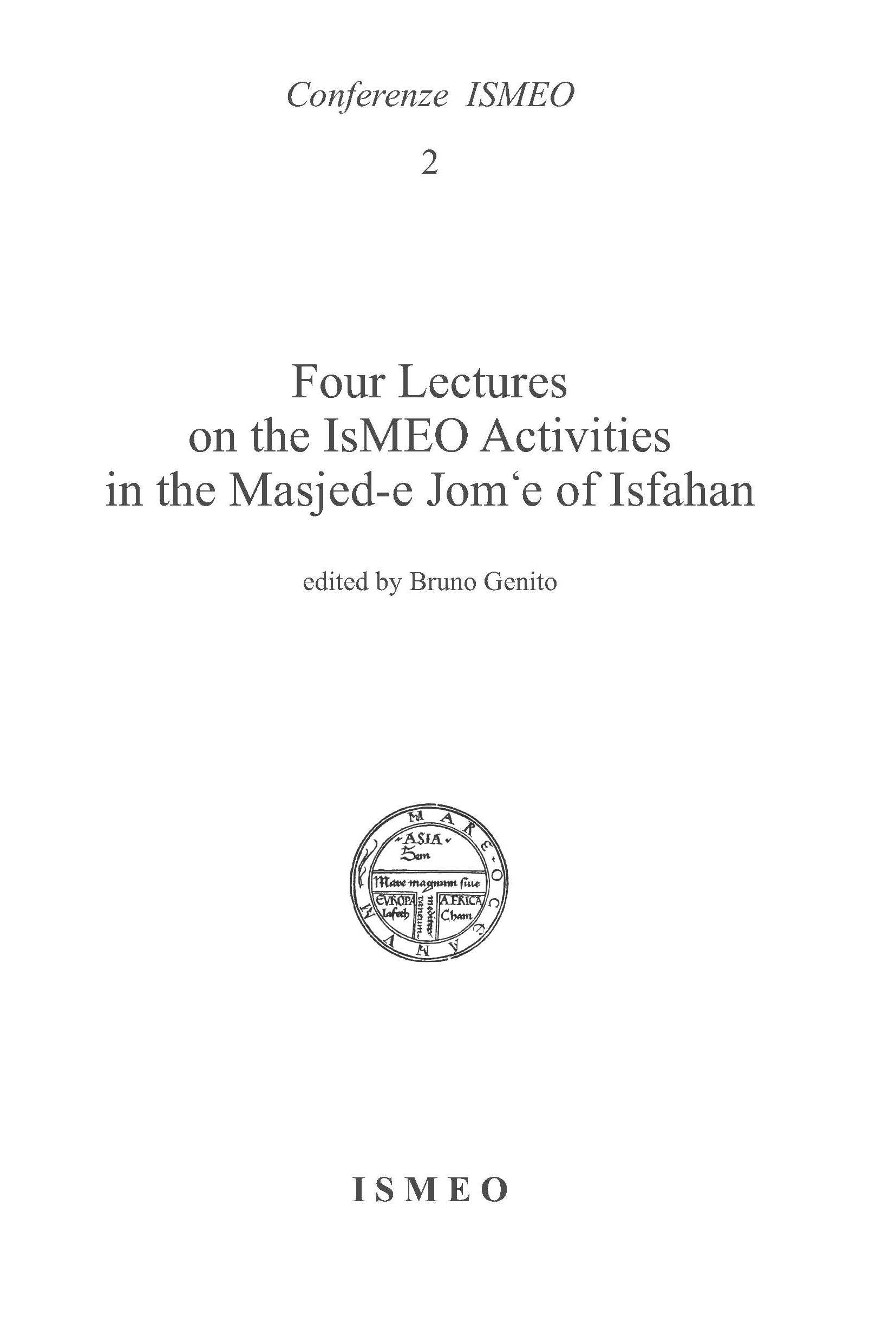Four Lectures on the ISMEO Activities in the Masjed-e Jom'e of Isfahan
Conferenze ISMEO 2
- Anno: 2018
- Autore/i: Bruno Genito (ed.)
- Catalogo: Scienze e Lettere
- Argomento: Archeologia
- Collana: Novissimo Ramusio
- ISBN: 978-88-6687-138-5
- ISSN:
PREFACE
Located in the historic centre of Esfahan, the Masjed-e Jom?e
(‘Friday Mosque’) can be seen as a stunning illustration of the evolution
of mosque architecture over twelve centuries, starting in 841 CE,
and now is one of the major Iranian sites inscribed on UNESCO World
Heritage List.
The Italian restoration activities carried out in Esfahan during the
1970s were planned and organised in collaboration with the Service
for the Restoration and Preservation of the Historical Monuments of
Iran (now Iranian Cultural Handicraft and Tourism Heritage Organisation)
(ICHTHO) and the Istituto Italiano per il Medio ed Estremo
Oriente (IsMEO, afterwards IsIAO). The restoration activities headed
by Arch. Prof. Eugenio Galdieri and the excavation activities headed
by Prof. Umberto Scerrato in the Friday Mosque were aimed in particular
at identifying the earlier constructional phases of the building:
amongst them the Abbasid, Buyid and Saljuq.
Historical circumstances did not allow for long time (1979-1998)
any Italian team to continue working at Esfahan. Only between 1999
and 2002 an Italian IsIAO team, under the invitation of ICHO (now
ICHTHO) and with the direction of the late Prof. U. Scerrato went
back to Esfahan, starting again the work in the Mosque jointly with
the Iranian colleagues.
Many years after the end of the actual excavations, a joint Iranian-
Italian Project named ADAMJI (A.rchaeological D.igital
A.rchive M.asjed-e J.om?e I.sfahan) has been aimed at providing a
gradual transformation of the whole set of original data and information
(written, graphic, photographic etc.) in a digital archive. The Italian/
Iranian Project jointly coordinated and directed from the Iranian
01 frontespizio_Giunta 01/05/2018 15:37 Pagina 5
side by Dr. Faribah Saeidi Anaraki and from the Italian side by Prof.
Bruno Genito, started in 2003 and ended in 2010.
A number of Institutions offered their precious contribution to the
realization of the joint work, the Italian Ministero degli Affari Esteri
(MAECI), the Sazeman-e Miras Farhangi Sanaye Dasti va Gardeshgari,
Tehran, the Sazeman-e Miras Farhangi Sanaye Dasti va
Gardeshgari, Esfahan and the Iranian Centre for the Archaeological
Research (ICAR), the Istituto Italiano per l’Africa e l’Oriente, Rome
(IsIAO), the Università degli Studi di Napoli L’Orientale (UniOr).
The idea of realizing a volume to illustrate to a wide public the
activities of the Project was first imagined by Ambassador Alberto
Bradanini who during the celebration day of 25th February 2010 suggested
to publish in the shortest time a collection of papers related to
the scientific work done in the Masjed-e Jom‘e. IsIAO decided to do
that, making use of some papers (never published) devoted to an exhibition
held in the National Museum of Iran, Tehran in December
2005, and adding further contributions in order to have a more complete
collection of subjects.
The volume, Adamji Project. From the Excavation (1972-1978) to
the Archive (2003-2010) in the Masjed-e Jom‘e, Isfahan, Tehran 2010,
was edited jointly by Faribah Saeidi Anaraki and Bruno Genito,
printed in Tehran and jointly published by the Italian Embassy,
Tehran, ICHTHO and IsIAO.
Since many circumstances hampered a wide circulation of the
book both in Iran and in Italy, ISMEO decided to republish some of
the essays (originariously conceived as public lectures), mostly in an
updated version, in his series “Conferenze ISMEO,” devoted to the
dissemination of high level scientific knowledge in Italy, also in the
hope to contribute to the knowledge of this monument without equal
in all the world.
ADRIANO V. ROSSI
President, ISMEO
CONTENTS
Preface by Adriano V. Rossi
R. Giunta, The Saljuq Inscriptions of the Great Mosque, Isfahan
S. Massa, An Immense Archive of Material Information Advanced Technologies Applied to Ancient Everyday Ceramic Objects
G. Maresca, Glassware from the Excavations at the Masjed-e Jom‘e in Isfahan: Brief Notes on the ADAMJI Processing Activities
B. Genito, Activities in the Masjed-e Jom‘e, Isfahan
F.to 14,2 X 21, pp. 88, brossura filorefe, Ill. a colori e B/N



